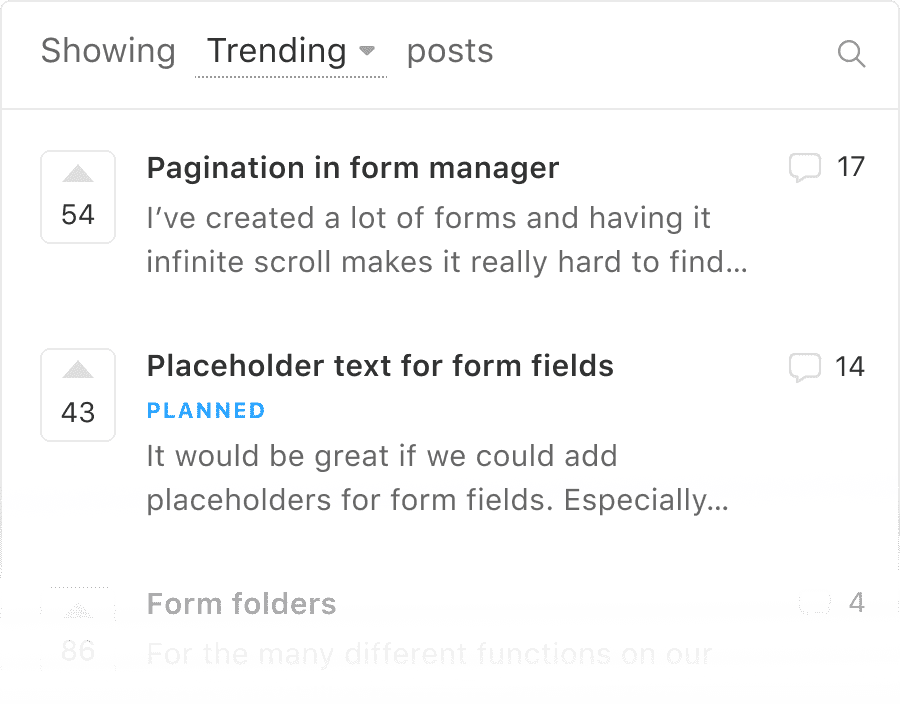There’s one accurate indicator of success: customer satisfaction.
This is why so many SaaS companies rely on feedback from customers. Customer feedback drives informed product improvements. On top of this, it helps you to stay ahead of the competition in a saturated market. You’ll know exactly what your customers want.
Product development is an intricate process, demanding ongoing trials and testing. This makes it easy to become inward-looking, which is why customer feedback can be essential.
Focus on customer perspectives rather than your own assumptions. This will help your feature adoption, conversion rates, and customer loyalty.
Discover strategies for integrating customer feedback into each stage of product development in this blog post. This will help you create more impactful products that your customer base will love.
What does product development entail?
Product development encompasses ideation, research, planning, testing, and launch.
Product development aims to ensure you can meet or exceed customer demand. This helps to maintain and increase your company’s market share. It’s equally about delivering customer value and quality. To help you achieve this goal, you want to maximize resources and reduce errors.
But it’s even more critical that you meet customer needs. To do that, you must factor in their feedback when developing products. After all, happy customers lead to increased sales!
Here’s a breakdown of the following stages:
- Product ideation. Brainstorming is crucial. Product managers and the development team throw around ideas. It’s a time for discussing potential products and seeing what resonates. Your idea might be for a physical product. This includes SaaS or PaaS platforms. At this point, you devise a list of potential concepts you aim to research and validate in the next stage. Or create a rough product roadmap for the final version.
- Product research. This is the stage where valuable feedback comes in. You want to confirm your product concept and determine product-market fit. After all, you don’t want to waste resources on something that won’t meet customer expectations. Conduct competitive analysis to identify existing competitors and market demand. Additionally, gather feedback to gauge customer sentiment.
- Product planning. It’s time to make your idea more concrete. Create a detailed plan that outlines the product design, features, and functionalities. Then, decide which category you’ll market it in. Finally, establish an ideal product pricing model. Make sure it aligns with your brand positioning and marketing strategy.
- Prototyping and testing. Bring your product to life by crafting a few prototypes or demos. Test their features and functions to identify which iteration performs best. You can even allow your target audience to test and review your prototype. This experiment can give you an actionable insight. Then, you can tweak your minimum viable product (MVP) before launch.
- Product launch. It’s go time! Prepare to promote your product and introduce it to the market. Gather marketing assets and collaborate with sales and marketing teams. You should also prepare other departments, including customer and technical support. If you’re a start-up, use this opportunity to discover available domain names. Today, .io and .ai are particularly popular in the tech landscape.
Collecting qualitative feedback can inform everything from your product development process to your customer journey. But analyzing the data will give you valuable insight into your business’s performance.

Whether during the brainstorming or testing stage, the customer feedback loop is critical. With that in mind, let’s look at how to gather these insights in the first place.
How to gather customer feedback
Already have a product on the market? Then, you might gather feedback through online reviews, feedback forms, or post-purchase emails. But if your product is still an idea, you must consider other customer feedback tools.
Here are some practical ways to gather customer feedback during product development.
- Surveys
Customer feedback surveys are an excellent tool for business owners and product teams. You can see whether there’s valid interest in an idea for a new product. You can also use surveys to gauge satisfaction with existing products.
After choosing a format and channel, pinpoint the key information needed. For example, do you want to gain customer insight into:
- Customer opinions around similar products already on the market
- Existing pain points that your product plans to ease
- Customer satisfaction and customer loyalty
Write a list of open-ended questions for your participants. This way, you can gather more detailed information. You can conduct these in several ways. You can run online surveys to a wider audience. Or you can use in-app surveys to target a select group of existing customers.
Whatever you choose, stick to only essential questions. Don’t overwhelm your users with long surveys. You’ll have a much lower response rate.
There are also several customer feedback software solutions. These help you create feedback questions that will lead to better response rates. They also assist with data analysis. So, later on, the team can make better product decisions based on accurate information.
Here’s an example of user feedback you can gather with the help of Canny.

Once your survey is complete, you can send it to customers over email. Automate these feedback requests to save you time. Schedule them immediately after a customer support interaction or specific time post-sale. Even if a customer doesn’t provide an email, you can locate one using an email lookup tool.
Slack, the messaging platform, heavily relied on customer feedback in its early stages. They used surveys to understand user preferences, leading to features like customizable notifications and a more intuitive interface.
2. Social media
You don’t have to ask customers for feedback. Consider using social listening and social media monitoring. You can use social listening to fine tune your product during the ideation phase. Or tune in to online conversations to see what customers say about existing products.
Let’s say that one customer experiences an issue with your product. Or they had a poor customer service interaction. Instead of contacting you, they post about their experience on social media. This might be Facebook, Instagram, TikTok, or even YouTube. Other people comment in agreement with them, and it soon goes viral.
If you’re not monitoring your socials, you risk missing out on this vital feedback. So, track mentions of your brand across social media. You can then use customer conversations to guide improvements.
Replying to negative feedback also shows you’ve taken feedback on board. Hear your customers out and take accountability for your mistakes. This can increase customer retention and even turn an unhappy customer into a loyal one.
If you’re still in the ideation phase, you can use a similar process. Monitoring mentions might help you see a gap in existing products. You can then develop a new product that includes the key features people are craving.
On top of this, you might use social media to analyze competitors’ products. What are they already selling that you can do better? Have they already developed a product that you had an idea for? If so, what do their customers say about it?
Take Adobe which monitors social media channels to gather user feedback on its software suite. Adobe’s responsiveness to user-reported issues on platforms like Twitter has led to several feature improvements and bug fixes.
This type of feedback will help you fine tune your idea and fill a gap in the market.
3. Usability tests
A usability test takes place during the product development stage. It first involves gathering representative users. You then observe them as they complete tasks and engage with your product’s key features.
Usability testing is a fruitful product feedback source. It allows you to observe customer behavior and collect valuable metrics. You can also ask representative users for insights to measure the customer satisfaction score.
Of all the types of customer feedback, usability testing is the most in-depth. Analyzing feedback gives you insights. These insights could impact the rest of your product development process. This includes:
- User behavior when interacting with your software
- Common issues customers came across
- Level of customer satisfaction
- More ideas for testing the product’s later versions
Usability testing can be time-consuming. But it generates more accurate data, allowing you to develop a more successful product.
Keep the customer feedback loop in mind no matter which method you choose. It’s not enough to gather customer data. You must use it to make informed decisions.
For example, you conduct a usability survey for a new app. Consistent feedback shows users experience the same bug. So, your product developers update the code for the program’s local environment. This reduces the chance of software bugs and makes it easier to debug in the future.
Dropbox is a notable example of using usability tests effectively. In its early days, Dropbox conducted extensive usability testing to simplify its file-sharing interface, significantly contributing to its user-friendly reputation.
Let’s look at a few more ways you might use feedback.
Five ways customer feedback informs the product development process
Customer satisfaction is everything if you want your product to succeed. So, feeding their opinions into your product development process is essential. Let’s explore the key ways to do that.
1. Discover market opportunities for new and existing products
User research and feedback provide clarity on your idea for a new product. You might think that the software is going to be a surefire hit. But what if a customer survey revealed the opposite?
A successful SaaS company serves the right product to the right audience at the right time. The feedback you collect during the product validation stage will be invaluable. Is there an actual interest in your product? Does it serve a purpose? Does it have longevity?
In parallel, work out whether there’s viable market potential. To achieve this, ask existing and potential customers product-specific questions, such as:
- Are you already using something similar?
- What do you like or not like about it?
- How would you like to improve it?
- Is it addressing your pain points?
Analyzing this data will inform your next move. Can you optimize the software to address the feedback? Or should you bench the idea altogether?
Feedback from existing customers is also useful for existing products. Those customer reviews can help you identify market opportunities for future ideas. Or you might realize your core products are missing essential features. Either way, this is beneficial for improving your market position.
2. Identify weak points
Will your product concept address customer pain points? Customer feedback management could help you answer that. It’s also beneficial for highlighting the product’s strengths and weaknesses. For example, ask your customers:
- What do you expect from the product?
- Do you think it’s useful?
- Can you envisage any potential issues with it?
- What extra features would be useful in the future?
A customer feedback tool (like Canny) can also help identify vulnerabilities. Ask customers about their concerns about product security and potential threats. This way, you ensure your product addresses these issues.
You can gather this data at various stages, including ideation and testing. The former will help you gauge how strong your idea is. The latter is useful for fine-tuning your product.
Microsoft’s development of Windows 10 is a classic example. The company invited users to join its Insider Program, where feedback from beta testers helped identify and rectify numerous user interface issues and software bugs before the official release.
3. Highlight the non-negotiable features
There’s no such thing as the perfect product. When preparing to launch, sometimes you need to go to market with a product with limited features. This may be down to limited resources. Or you may want to hold a few things up your sleeve to encourage more subscriptions later.
But it’s crucial to include the most in-demand features. Use customer feedback to identify the functionalities they deem most important. Is there anything your customers would consider non-negotiable? If so, did you and your product team envision those features already?
Take this as an invaluable opportunity to fine-tune your product ideation. This will help you single out priorities to focus on for success. It also allows you to create the best product, even on a limited timeframe and budget. Valuable feedback from customers helps you focus on product features and plan ahead.
4. Shape better marketing and sales strategies

Great, you’ve gathered enough data to confirm your product idea’s viability. You shouldn’t stop there, though. Keep gathering customer feedback even after you’ve launched your new product. This can help you refine your marketing and sales strategies.
Another great idea is to repurpose customer feedback in your content marketing campaigns. User-generated content (UGC) can help a lot with this. Turn positive feedback and reviews from customers into UGC. Then, share this content on social media. This might include testimonials or videos of real customers using your product.
Using feedback, you can strengthen your product’s position on the market. And you can show customers that you value their opinions and want to hear their voices.
The result? Happier customers, higher retention rates, and an increase in customer advocacy.
UGC may also come in handy if your product is complex. Consider some of the more technical and nuanced elements of software solutions. These might need more in-depth explanations. You want customers to enjoy your product features.
For example, let’s say feedback flagged customers’ questions like “What is containerization?” or “How do I integrate this software with my existing CMS?”. By creating UGC, you allow real users to explain these concepts digestibly.
Airbnb utilized user feedback to reshape their marketing strategies. By understanding that users valued unique travel experiences, Airbnb shifted their marketing focus to highlight unique listings and local experiences. This significantly boosted their brand appeal.
5. Promote the product’s uptake
Earlier, we touched on the importance of developing a series of prototypes. This can help gauge if and how your product works in the real world. Customer feedback can come in handy here, too.
Collecting feedback at this stage allows you to identify the best product version. This will help you focus on refining it and increase its chances of uptake post-launch. Listen to the opinions of real users who interacted with your prototype. This gives you a clearer idea of how end customers perceive the final version.
These insights allow you to fine-tune the prototype. You can also iron out technical issues and incorporate popular features. So, more people are likely to adopt your product once it’s released.
The bottom line on how to use customer feedback for product development
The value of customer feedback is crucial for businesses. Many companies are tapping into feedback to inform decisions, from pricing to usability. But you shouldn’t only think of feedback as a post-purchase strategy.
Customer feedback is instrumental to the product development process. This is particularly relevant if you’re a product manager in the SaaS industry. It can make all the difference when it comes time to launch.
You can use a combination of feedback emails, usability tests, and customer surveys. It doesn’t matter which tool you use. Your customer feedback strategy should include the entire product development process.
But it’s not about gathering the data. Breaking it down and acting upon it is crucial. Analyzing feedback helps you work out issues, promote uptake, and shape future strategies. Overall, it’s a brilliant way to ensure the success of your SaaS product and improve the customer experience.






